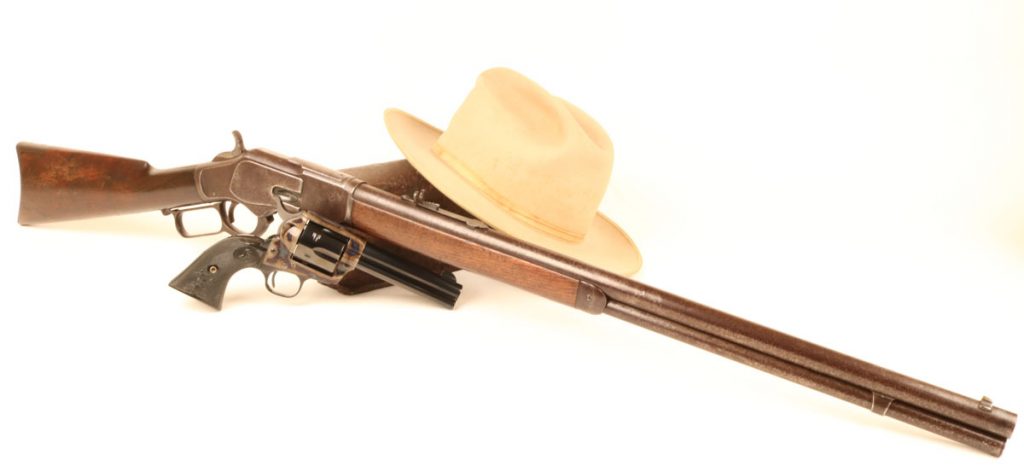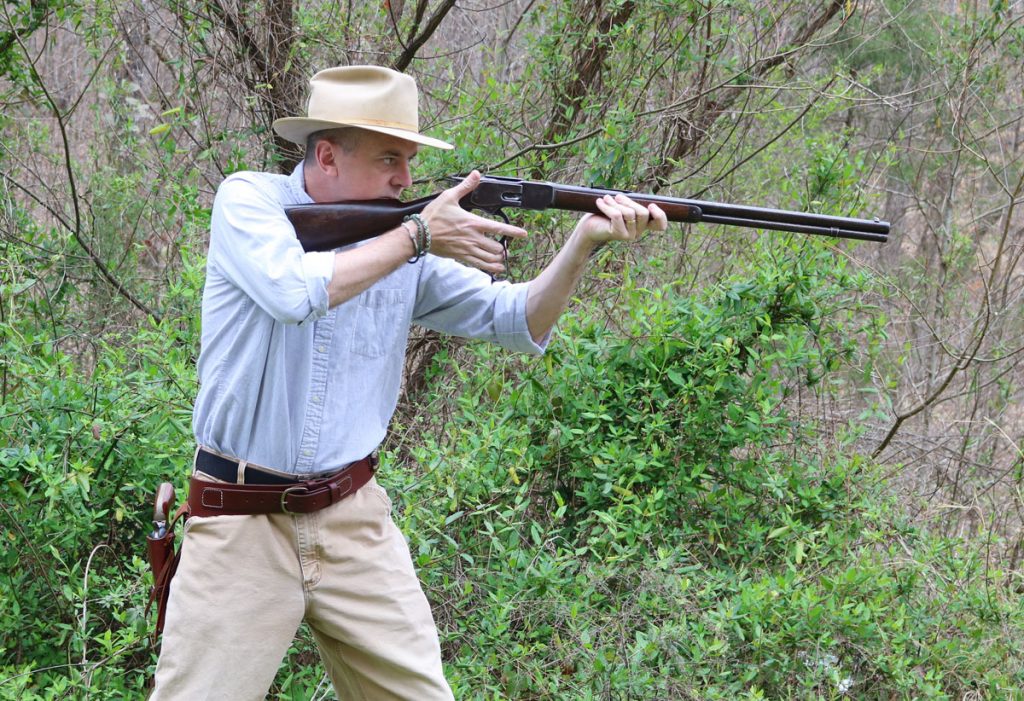Sometimes a term is used improperly with such lamentable frequency that it worms its way into the lexicon of accepted speech. Texting, doping, ROTFL, and LOL are some common offenders. So it is also with the ambiguous moniker Assault Weapon. Nobody can ascertain with certainty a precise definition beyond that its very existence seems to unsettle the less durable members of society. However this nebulous term might be applied, the Assault Weapon as a concept is not unique to the Information Age.
In the 1870’s the nation still reeled from the recent Civil War that had very nearly ripped it asunder. Emotional wounds were still raw, and the frontier beckoned the disenfranchised, adventurer, and malcontent alike to an exciting new life in an untamed world bereft of rules. In such a rugged land the possession of a proper firearm frequently spelled the difference between freedom and enslavement, wealth and destitution, or even life and death. With so much riding on the details, the flower of American engineering prowess strived to produce the optimized hunting and defensive tools. The legendary Oliver Winchester proffered his eponymous firearm to the masses via the magical combination of reliable performance and shrewd marketing. His Model of 1873 had a veritable pantheon of parents.

Oliver Winchester touted his Model 1873 as “The Gun That Won the West.” Graceful, reliable, and accurate, the 1873 Winchester was a high-capacity repeater that fired a potent centerfire cartridge.
Origin Story
The lever action 1873 could trace its origins back to the Volcanic repeating rifle birthed in 1855 by Daniel Wesson and Horace Smith. The Volcanic repeater was as much a cartridge as a rifle and in that respect was really too much too fast. Those early self-contained Volcanic cartridges were caseless after a fashion sporting an exposed powder charge in the base of a conical bullet. While the materials science of the day could not produce a reliable caseless round that could withstand the rigors of foul weather and rough handling, the subsequent generation was much more promising.
With economic failure a certainty, Oliver Winchester, a clothing magnate, bought out the interests of both Smith and Wesson and reorganized the failing Volcanic company in his own image. The resulting New Haven Repeating Arms Company employed one Benjamin Tyler Henry as its chief foreman. By 1860 Mr. Henry had improved upon the Volcanic mechanism and married it to the then-revolutionary .44 rimfire metallic cartridge. While this fortuitous relationship was indeed an improvement, there yet remained a catalyst of some sort required to make the radical and expensive design truly successful. That catalyst came in the form of the American Civil War. It’s always preferable to be lucky than good. In the case of Oliver Winchester, he enjoyed both attributes in comparable measure.
More than 14,000 Henry rifles saw service during the war. Southerners facing these remarkable weapons in action came to respect their prodigious firepower when compared to the muzzle-loading muskets of the day. In 1866, right after the war ended, the Henry rifle got an upgrade in the form of a side-loading gate, wooden fore-end, and sealed tubular magazine. Nelson King designed these features and his name is roll marked on the barrel of my vintage Winchester rifle. The model of 1866 was the first model to formally take on the name Winchester. The 1866 Winchester sported a two-pronged firing pin that struck these early rimfire rounds in two places for more reliable ignition. 170,000 of these 1866 rifles rolled off the lines before production halted in 1898.

Nelson King’s name is included in the roll mark on the barrel as “King’s Improve-ment” listed before the patent dates.
In 1873 the improved Winchester action met the centerfire metallic cartridge, and that’s when the real magic blossomed. In the 1873 rifle rugged individualists finally found a gun that was accurate, reliable, and weatherproof. These early rifles were chambered for the .44-40 Winchester round. Other terms used for the same cartridge were .44 Winchester Centerfire and .44 WCF. Later versions fired the .32-20 and .38-40. Winchester could not chamber his rifles for the .45 Long Colt round as Colt held the patent on that particular cartridge. Regardless, in the .44 WCF the frontiersman had a rifle that could theoretically fire the same round as his handgun.

One of the appeals of the 1873 Winchester was that it could conceivably fire the same round as a man’s handgun. Ammunition commonality made logistics easier on the frontier.
Winchester was a master marketer, and he contrived a variety of angles to separate Americans from their hard-earned cash. Not unlike today, gun nerds simply had to have the best, fastest, coolest smoke pole on the market. In the process, he made a literal killing. When his fortune went to his widow after his unexpected death in 1880 she became one of the wealthiest women on the planet.
Morphology and Variations
The 1873 Winchester sported a steel receiver along with proper metallurgy in its barrel that allowed the gun to handle the relatively high performance of the .44 WCF round. Various barrel lengths and contours, engraved variations, and rifle, carbine, and musket versions kept things spicy. By announcing that the very best barrels were incorporated into special edition versions Winchester sold his one-of-one hundred and one-of-one thousand rifles. There were eventually eight of the former and one hundred thirty-six of the latter. Possession of one of these guns today is the functional monetary equivalent of a generous trust fund.

Oliver Winchester touted his Model 1873 as “The Gun That Won the West.” Grace-ful, reliable, and accurate, the 1873 Winchester was a high-capacity repeater that fired a potent centerfire cartridge.
More than 720,000 1873 Winchesters were produced, and the last original copy left the factory in 1923. One-of-one thousand rifles sold for a cool $100 in 1875, the modern-day equivalent of about $2,200. Eventually, John Moses Browning got involved and improved the design yet again into the model 1894, but that is a story for another day.

There is a pivoting lock on the bottom of the tang that will hold the action closed manually if need be.
Italian replicas of the 1873 Winchester enjoy unflagging esteem today thanks in large part to the popularity of Cowboy Action Shooting. Modern versions are also produced in a number of variations in Japan and then sold under the original Winchester banner. A 2018 SHOT Show special of the venerable Winchester gun was the Model 1873 Deluxe Sporting rifle. Chambered for .38 SPL/.357 Magnum, this modern reproduction sports a 24-inch barrel and an MSRP of $1,799.

The top-mounted sliding dust cover retracts automatically when the action is cycled. Nelson King added the side-loading gate to the original Henry repeater and made it markedly more efficient.
Handheld History
My 1873 Winchester was produced in 1891 and was a barn find of sorts. A friend’s dad found the gun in an abandoned house, and he sold it to me at a fair price when he needed tires for his truck. The rifle has seen its share of action yet remains mechanically sound. It is simply gorgeous to behold.
There is a rotating lock that secures the lever action in the closed position, and the rifle indeed loads via a spring-loaded gate on the right side of the receiver. The sliding top-mounted dust cover opens automatically when the action is worked. A bronze lifter feeds the rounds into position for chambering and helps eject the empties while lending the rifle a fascinating mechanical elegance. The external hammer cocks of its own accord but can be manually lowered to render the gun safe. There is no manual safety.
The rear sight is ramp adjustable and the forward version secures via dovetail. The buttplate sports a deep crescent that secures the gun in firing position as though it was in a vise. There is a buttstock trap for accouterments. The aged walnut sports that inimitable feel and hue so characteristic of that enchanted material and contrasts nicely with the gun’s worn patina. Working the action manually today produces the same glass-smooth cycle that so impressed cowboys back in the 1870’s. This process on my gun has been made velvety by literally countless repetitions.
Denouement
Oliver Winchester touted the 1873 Winchester as “The Gun That Won the West.” As the victors write the history, that claim fits tidily within our sanitized frontier narrative. Civilization is objectively preferable to chaos, so in that vein such conquest was inevitable.

The 1873 Winchester was the AR15 of its day. Popular, potent, and powerful, this lever action wonder gave its wielder a decided advantage in armed combat.
In reality, the 1873 was the AR15 of its day. Wielded by hard men on both sides of the law as well as determined homesteaders facing daunting odds, Oliver’s revolutionary rifle was indeed a splendid equalizer. Then as now, a man with a gun was a citizen, while a man unarmed was either a victim or food. Whether the threat was untamed savages, shifty ne’er-do-wells, or carnivorous fauna, the 1873 Winchester protected home and hearth while ably keeping the cooking pot filled. In so doing it was the embodiment of the 19th century concept of the Assault Weapon.

The Winchester 1873 revolutionized armed combat. Light-years ahead of its contemporary competition, the Model 1873 was the Assault Weapon of its day.

The 1873 Winchester has no manual safety. There clearly weren’t so many lawyers back then. To safe the gun you carefully lower the hammer manually.

There is a pivoting lock on the bottom of the tang that will hold the action closed manually if need be.





